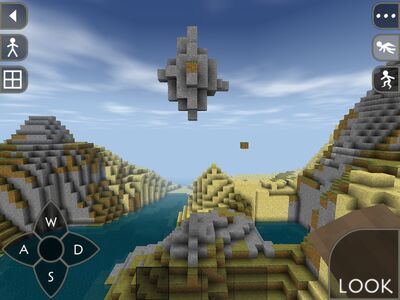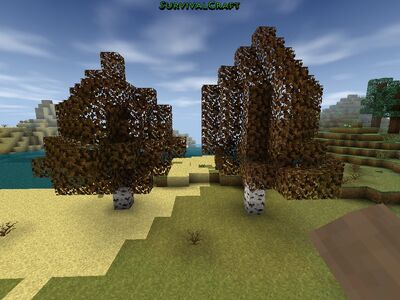Description
Biomes are areas in the world that have differing plant life, animal life, temperature, and humidity, regardless of the terrain they cover. Some biomes are mainly associated with certain terrains however. For instance deserts are rarely found in mountainous terrain. The ocean and other water features will also have different biomes within them.
Other special terrain features are also included on this page.
Note: See Terrain for other details.
Desert
The desert is the driest biome in Survivalcraft. There is no vegetation or plant life except for cacti. dry bushes and large dry bushes are abundant. Very few animals are present other then typical desert dwellers.
The terrain is usually fairly flat, but you can see some hills and small mountains.
Pros:Desert is not too good for living.
Cons:There are almost no trees, no vegetation. Only some animals are better food source. Such as Cassowary and Camels. Dangerous animals are dwell in this area well. As Hyenas, Coyotes, Lions etc. So that is not too good.
Wasteland
The wasteland consists of dead coloured grass, and no plant life [except for dry bushes]. graves and Grasspits are commonly found in chaparrals. Not very many animals present. In this biome generates Mimosa trees. Slightly cold, but not too cold like snowy forest.
Terrain is usually slightly hilly.
Pros:Wasteland is not too good.
Cons:Trees are less frequent. And this biome is slightly cold. So if you don't have better insulation clothes, You may get flu. Also black bears spawn here, which is very dangerous.
Temperate Forest
Temperate Forests are warm, semi-humid biomes. They consist of many trees, usually birch and oak. A lot of plants and vegetation are growing. Many animals are found here.
They range in terrain. They can be super flat or have high mountains.
Pros:Forest biome have many trees. Which are useful. Also you can find pumpkins here. And food source animals are more frequent than other biomes. Also there are many plants, such as cotton and ryes. So that is good for living.
Cons:There are some dangerous animals. As Tigers, jaguars etc. So you need to be always careful.
Tropical Forest
Tropical Forests are hot, humid biomes. They consist of many trees, usually oak. This is the only biome in which ivy is present, found hanging in the entrance of caves and on the foliage of trees. A lot of plants are found here. Many animals are also found.
Tropical Forests are usually hilly.
Tundra & Taiga (Snow Forest)
Tundra biomes are the coldest and least humid. Pools, ponds and lakes usually freeze over. They are home to spruce trees and few animals. No other vegetation grows here.
Taiga biomes are basically the above biome but including an abundance of spruce trees and occasionally tall grass.
Cold-dwelling animals can be found in both Tundra biomes and Taiga biomes, including Tigers, Black Bulls, Black Cows, Wolves, Black Bears, Polar Bears, the rare White Bull and the super-rare White Tiger.
Care must be taken when traveling across cold and snowy biomes, as the player can literally freeze and die quickly of hypothermia. Surviving is possible with a reliable heat source (Lava, fire) or fur clothing which maintains body heat.
In either biome, terrain altitude ranges. Can be super flat or mountainous.
Other terrain features
Other terrain features that cannot be categorized as biomes.
Ocean (Terrain)
The ocean consists of deep water, marine life and rare whales. Temperature ranges. Clay, sand and dirt is abundant on the sea floor.
The ocean changes colour from royal blue (Cold temperature) to turquoise (Warm, humid temperature) depending on the climate.
Beaches/Shoreline (Terrain)
The shoreline can be hot or cool, depending on what biome you are in. Sandy and gravel shorelines are found in Jungles/Forests, and icy shorelines are found in Snowy biomes. Beaches can be either sand or gravel.
Beaches are nearly always flat.
Magma and Water Pools (Generated Structures)
Magma and water pools spawn randomly in caves. They can be dangerous when mining as the player can either;
A) Drown
B) Fall in lava
C) Die of hyperthermia (See Body Temperature)
Mountains (Terrain)
Mountains are usually spawned in Jungles made from dirt and granite, but in or near Wastelands, you can find stone mountains as well. Coal ore is plentiful on these mountains.
Islands (Terrain)
Islands are found randomly throughout the ocean. The picture shows 2 different biomes on one island mountain. It's also an example of a desert biome on a mountain.
Floating Islands (Generated Structures or Terrain?)
Floating islands can be found randomly throughout your world. They are a glitch, and simply float without any support.They are not uncommon and are usually found in the desert.
Sand and gravel are both Falling Blocks, but some floating islands made of either stay afloat even if the world is in living mode, where gravel and sand fall if they are placed without a supporting block underneath them.
Foliage Colour
Foliage colour differs throughout different biomes. For example, a birch tree planted in or near a desert will have reddish leaves and appear dry whereas a birch tree planted in a forest or jungle will be lush and green. The same applies to grass - both the grass block and growing or dead grass plants. It also applies to Christmas trees, Ivy and leaves.





















